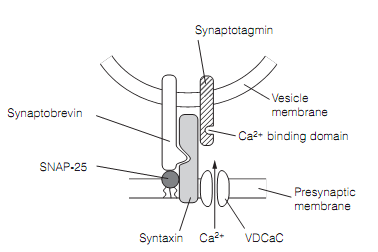Biochemistry of exocytosis
The Exocytosis from SSVs includes numerous linked steps, most of which require calcium. The Nerve terminals hold two pools of SSVs. The releasable pool is positioned at the active zone and can take part in repeated cycles of exocytosis and endocytosis at low firing frequencies. The reserve pool holds of vesicles tethered to cytoskeletal proteins, and can be recruited by the repetitive stimulation to join the releasable pool. The liberation of a vesicle from the cytoskeleton needs Ca2+-dependent phosphorylation of synapsin I, a protein which anchors the vesicles to actin filaments in the terminal.
The Vesicles are aligned at particular sites in the active zone by a process known as docking, that includes SNARE proteins as shown in figure. The vesicle-related protein, synaptobrevin binds with high affinity to a presynaptic membrane protein, that is syntaxin (t-SNARE).
The Syntaxin is closely realted with voltage-dependent calcium channels, assuring that the release machinery is optimally placed to receive the Ca2+ signal. The Synaptobrevin and syntaxin, altogether with a third protein crucial for docking, the SNAP-25, are aims for botulinum and tetanus toxins which are powerful inhibitors of the neurotransmitter secretion.
After docking comes the other calcium-dependent step, priming, in which the number of soluble cytoplasmic proteins form a transient complex with SNAREs, resulting in a partial fusion of vesicle and presynaptic membranes. This step includes the hydrolysis of ATP.

Figure: Proteins included in the docking of neurotransmitter vesicles.
The Primed vesicles are poised for exocytosis, needing only a large pulse of Ca2+ to allow complete fusion of the vesicle and presynaptic membranes and opening of the fusion pore via which the exocytosis takes place. The calcium-binding protein positioned in the vesicle membrane, synaptotagmin, is the Ca2+ sensor in the exocytotic machinery. In the absence of calcium it prevent complete fusion, however when it binds Ca2+ it undergoes a conformational change that permits fusion to proceed.